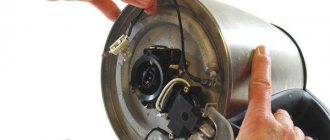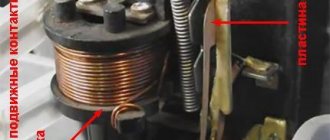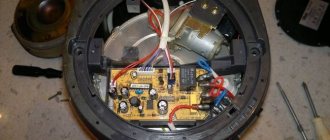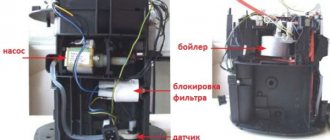Household appliances have become a part of our lives and have greatly simplified them. There are both pros and cons to this at the same time. On the one hand, household transactions have become much more convenient. On the other hand, if the refrigerator, washing machine or stove breaks down, most will not know what to do.
Problems can arise with any household appliance. The teapot is no exception. Cases are different. But one of the most common is that the kettle does not turn off when it boils. Let's figure out why.
Electric kettle
Kettle design
To deal with the breakdown, you need to understand the principle of operation of the equipment.
The design of the kettle is extremely simple. After pressing the power button, electricity is supplied to the heating elements. They are called heating elements, or tubular heating elements. The heating element is located either in a special stand or in the bottom of the device itself - it depends on the model.
The water gradually warms up. After crossing the threshold, hot steam begins to form. Since the lid is closed, the steam needs to escape somewhere. For this purpose, a channel is adapted that leads to the shutdown button. In front of the switch there is a bimetallic plate that acts on it. This mechanism disconnects the equipment from the network.
Device operation diagram
If the kettle does not turn off, it is considered a warranty case.
However, like any device, it can fail. Having collected water and plugged in the device, while running off for a couple of minutes to call your colleagues for tea, you can return and find a Finnish sauna, the cause of which was a steaming electric kettle. In this article we will figure out why the kettle does not turn off when it boils and how to fix it yourself.
- Causes of malfunction
- How to fix it yourself?
Causes of malfunction If the kettle does not turn off when boiling water, then the causes of the malfunction may be:
- its lid is not closed;
- large gap between the cover and the body;
- there is no filter or it is unevenly positioned;
- scale formation on the walls.
- the switch or the bimetallic plate that acts on it is broken.
Below we will look at instructions for repairing a kettle that does not turn off when it boils.
As for expensive or cheap teapots. If you buy an expensive kettle, it is not a fact that it will last longer. And if you divide the cost of one expensive kettle by the price from a cheaper segment, it turns out that kettles can be replaced more often (even due to their failure). Expensive does not mean a guarantee of durability. Moreover, the model range is constantly changing and there is an opportunity to buy a new model (albeit cheaper).
We should not forget the fact that our life is not the Soviet Union, where they did both for the military industry and for the civilian industry with uniform state standards. The current commodity producer (from anywhere on the planet) is not interested in his product working for approximately Eternity. The quality is within the warranty period (this is in the best case).
Causes of failure
Now that the principle of operation is known, it is much easier to understand why the electric kettle stopped working and does not turn off on its own when it boils. There may be several reasons:
- The most common reason is that the lid is not closed, or is not closed tightly. Instead of steam moving through the channel, it will escape through the cracks to the outside. Because of this, the shutdown mechanism will not work.
- There is no filter or it is installed unevenly. Because of this, the lid does not fit very tightly to the edges. Gaps are formed through which steam escapes.
- If you don't take care of your kettle, scale will form over time. This will be immediately noticeable by the plaque inside.
- The steam outlet channel is clogged. This can happen in older models. In newer ones, the creators took this shortcoming into account.
- Breakage of the switch. Changes are mandatory without exception.
- Damage to the plate, which cuts off electricity when heated. Of course, in this case you can turn off the kettle manually. But it is still advisable to repair it to avoid fire or smoke.
- Contacts sticking. Simply wipe and clean the contacts with sandpaper to solve the problem.
Some of the reasons can be solved by prevention and proper care of the kettle. Descale, close the lid tightly, turn off the kettle during power surges and do not heat it many times in a row. For other faults, DIY repairs are possible. You just need to know what exactly to do.
When to contact a specialist
Experts do not advise starting to repair an electric kettle on your own in the following situations:
- when a person does not have the necessary knowledge and practical experience in this matter;
- when a breakdown is observed in the thermostat;
- in a situation where a crack or chip has formed in the body of the kettle;
- when it is necessary to change or repair the heating element in a model with a closed type of heater.
Electric kettle repair
Thus, premature shutdown of an electric kettle even before the water boils can be caused by a large amount of scale on its walls and heating element or a breakdown when the thermostat or fuse fails. Other reasons are chips and cracks on the case or poor fixation of the heating element inside the device. If scale can be cleaned at home, then in other situations it is better to contact a service center and have the electric kettle repaired.
Video about turning off the kettle
Useful articles, news and reviews on our Yandex Zen channel
The electric boiler was invented a long time ago and is extremely simple in its functionality. But in the modern world, program-controlled devices are already in use, which will not only boil water at a set time, but also maintain its temperature at a given level for quite a long time. Regardless of the simplicity or complexity of the design, any thing is subject to malfunctions. One of them is that the kettle turns off before the water boils. It is this problem and ways to eliminate it that will be discussed in this material.
How to fix a kettle yourself that won't turn off when it boils
First of all, the device must be inspected for visible damage. Are there any cracks or chips from which steam can escape? Is the lid tightly closed?
Open lid
If everything is in order on the outside, then you should look inside. Perhaps the filter is not inserted too tightly and is sticking out. Because of this, the lid does not close - this is one of the most common reasons.
Next you need to check if there is any scale underneath. If there is one, it makes sense to thoroughly rinse and clean the insides.
In older models, the steam channel may become clogged. Check the hole. It can be found on the side of the kettle handle. This problem shouldn’t arise in new models, but it wouldn’t hurt to check.
If you have examined all the visible parts, but there are no problems with them, then it is time to disassemble the kettle and get to the switch and bimetallic plate. To do this, you need to carefully unscrew all the retaining screws.
It is advisable to record the dismantling process on camera. This will make it easier to assemble the parts into place later.
- If the switch fails, it must be replaced. It is no longer possible to repair it yourself.
- If the contacts are stuck to each other or burnt, you will need sandpaper. It is necessary to carefully wipe each contact for several minutes. Then remove the scratches with thick felt and you're done!
Disassembled device
After fixing the problem, you need to reassemble the kettle. But it’s too early to include it online. Even if you assemble it according to the instructions, you can make a mistake.
To eliminate this possibility, you need to place a towel under the bottom and wait about half an hour. If the towel does not get wet during this time, then the kettle is assembled correctly. And even then it can be connected to the network without any problems.
Disassembling the electric kettle
To understand why the device turns off prematurely, it is necessary to partially or completely disassemble it, which will allow you to quickly find the faulty unit and repair it or completely replace it. The dismantling algorithm will be considered using the example of a kettle from a brand manufacturer - Bosch. At the bottom of its case there are four screws that need to be removed. To do this, select a screwdriver that matches the screw heads. A cross is usually suitable.
But recently, the manufacturer has begun to use protection against attempts at self-repair. For example, he can hide the bolts under plastic plugs, which can be easily pulled out by prying them with something sharp. Or use one screw (or all) with a non-standard head. Then you will need a two-pronged fork type screwdriver, which can be replaced with tweezers. You can also do it yourself by sawing a groove in the flat blade of a regular screwdriver with a needle file.
Advice! If the self-tapping screw does not want to unscrew, then the easiest and fastest way to deal with this problem is to heat it up a little by applying the switched-on soldering iron to the head. The plastic will soften slightly and the screw will come out easily.
The last level of protection is the clever latches on the case and the lid itself. There is an opinion that sometimes removing the cover is more difficult than making the repair itself. In this case, two thin screwdrivers will help. The first one is pushed under the lid to create a gap. And the second one in this gap is to find the place of the latch and carefully release it.
Important! After disassembling the electric kettle, be sure to check all wire connections for integrity. Loose contact can cause many problems, including early shutdowns.
Fire safety
Why is it worth paying special attention to equipment if it does not turn off on its own? The point is the risk of losing your property. And it's not just a teapot.
Pampered users are accustomed to the fact that almost all equipment works automatically. And many can put the kettle on to warm up and go to another room or leave the apartment altogether.
The water gradually begins to evaporate. Eventually, the process will reach the point where there is absolutely no water left in the equipment. And if the kettle simply breaks down, it will be a huge luck. After all, there is a risk of fire.
Therefore, in case of such a breakdown, you need to pay special attention to the electric kettle. And either immediately start repairing it, or not use the device.
How to fix it yourself?
The electric kettle is designed in such a way that when water boils, steam collects under the lid and, having reached a certain concentration, is sent to a special section in which the switch is located. The latter, in turn, when heated, automatically releases the button, thereby disconnecting the kettle from the network. You can clearly see the design of the device in the diagram below:
The first step is to inspect the electric kettle; perhaps in a hurry and in anticipation of a break, a colleague at work did not close the lid tightly, or an uneven filter prevented the lid from closing tightly. Please note that an open lid is the most common reason that the kettle does not turn off when boiling.
If everything is in order with this, then you should look inside the electrical appliance. On the side of the handle, between the lid and the wall, there is a hole for discharging steam to the switch. It must be clean, without any obstructions or scale plugs. In old electric kettles, the hole is small and very often gets clogged, as a result of which the device does not turn off on its own when the water boils. New models do not have this drawback, so if you want to replace the device, we recommend that you read our tips for choosing an electric kettle for your home.
If you examined everything in order and did not find the reason, most likely the electric kettle does not turn off automatically when it boils due to the switch. To get to it, you will have to disassemble the device almost completely. To do this, you need to unscrew all the screws on the bottom cover, remove it, unscrew the screws on the handle, and remove it carefully without damaging the latches. Try to remember the sequence of your actions so that after repair you can quickly assemble the case.
When to take it to a specialist?
Device repair
Breakdowns are not so simple. Then you can’t eliminate them with your own hands. If the microcircuits are completely out of order, the switch is covered, and the plate does not work, it means that the equipment was not operated correctly.
Now you need to calculate whether it makes sense to restore the kettle. What is its cost? How much will it cost to repair and purchase new equipment? What will be more profitable?
If it would be more profitable to repair an old kettle, then you should take it to a specialist. He knows how to fix it.
The most economical thing would be not only to buy good branded equipment with a guarantee. But also use it correctly: pour clean water, clean it on time and do not overheat. But if problems still arise, the instructions above will help you restore the device.











